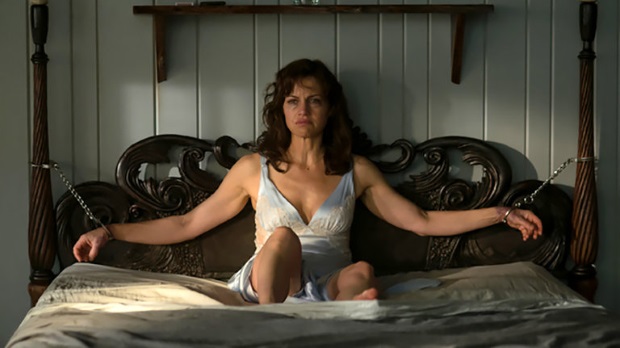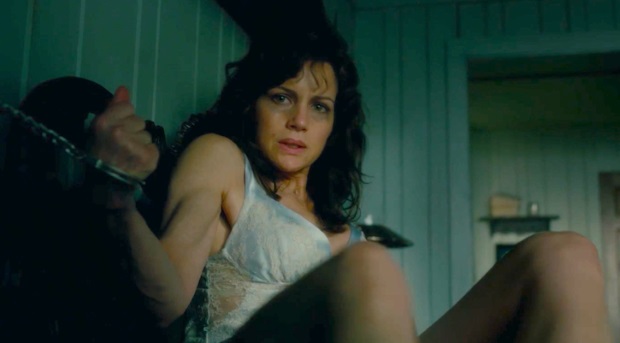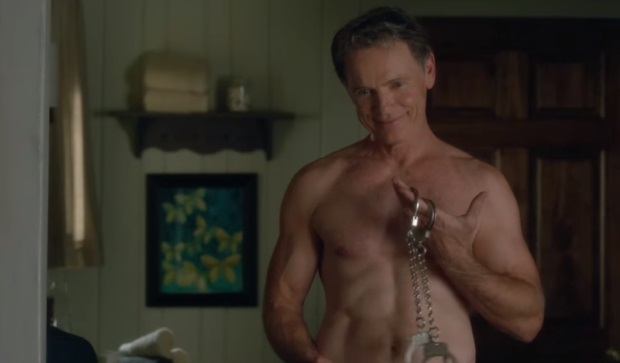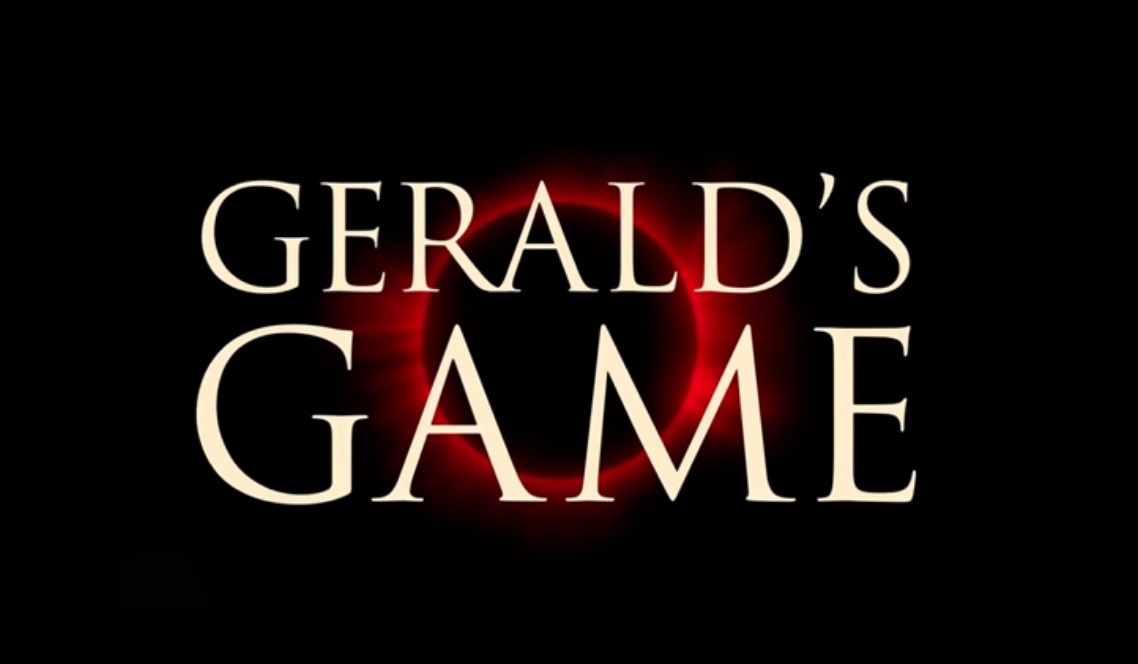Mike Flanagan isn’t the big brand name that Stephen King is – not yet, anyway – but I’ll admit it, had it been announced that somebody else was adapting King’s novel Gerald’s Game, my excitement would have been severely tempered.
But Flanagan did get the gig, and so I’ve been waiting impatiently for his film for months now. Happily, I was not even the slightest bit disappointed. Flanagan’s adaptation is, while being very true to King’s original, a brilliantly original, cinematic, effective and powerful work.
Last week, I spoke to Flanagan and Trevor Macy, the film’s producer, about how they pulled off such a tricky adaptation, as well as Flanagan’s next gig adapting Shirley Jackson’s classic The Haunting Of Hill House into a “ten hour movie”. Here’s how the conversation went.
The layman’s idea of shooting somebody in the same room over and over again is that the camera angles might get boring and need ‘spicing up’, but that’s just the surface of things, isn’t it? When you were thinking about so much taking place in one room, what were your thoughts of how to approach this with the camera?
Mike Flanagan: We knew that we couldn’t really repeat ourselves with our shots. I tend to over-prepare my shot lists. I had Michael Fimognari, who has been my DP since Occulus, and we knew that given the limitations of the space, we’d have to carry the audience through the whole story. We knew the camera would have to float around like the eye of god. We were very careful to make sure that we were never tedious or repetitive.
There are a couple of camera ideas that seem to come up at particular times. There’s the old standby of a push in on a character as they realise something. That certainly happens a couple of times. What were your other ideas in how to frame Jessie?
MF: Jessie dictated what the camera was up to. If she was turning inward, we had to push in; if she was focusing outward, we had to go wide. More than any other movie I’ve worked on, the camera had to be an extension of Jessie’s state of mind. Luckily, for me, [Stephen] King wrote such a compelling protagonist. It was very exciting to try and keep up with her.
So, very broadly, you’re saying that the more introverted Jessie is in any moment, the closer the framing.
MF: That is true. The more she was ‘in her head’, the closer we got with the lens. We also wanted to be up there with her in a very intimate way whenever she was attemtping to physically free herself from the situation.
A little way in, actors start spiking the lens, looking right into it. The first time it happens, it’s quite striking and seems to underline that we’re seeing something… well, not real.
MF: If you break the fourth wall, it involves the audience immediately, to put them in the room. Yes, you’re right, that tended to be the most appropriate when she was experiencing something in her head.
Would you like to give any good examples of how this room was designed and built to express Jessie’s experience?
MF: We wanted the room to be neutral so that Carla could project the character onto it. There is a fun little easter egg in there in that fans of Occulus might recognise the headboard of the bed. It’s actually the bottom of the Occulus mirror!

Oh, I thought it was just another prop ‘in the Flanagan style’ and not literally the same thing. That’s brilliant.
MF: It is! The artists that designed that headboard is Bruce Larson who also designed the Occulus mirror, the Hush mask and the Canker Man from Before I Wake.
Ah, the Canker Man! I don’t want to get into spoilers but several of your films feature characters or beings that seem to manifest, at least for part of the story, an idea, or a character’s struggle. I wonder if that wasn’t part of the original appeal in Gerald’s Game for you?
MF: You know, I don’t know. I am always fascinated by the mental struggles that people and characters have. Gerald’s Game had such an impact on me when I read the book in college that I think I’ve actually, consciously or unconsciously, been incorporating elements of that story into my work ever since. But I know that I’m only really interested in a story if I can remove all of the genre elements and still be fascinated by the characters. This is certainly in that wheelhouse.
This story is definitely being told by the makeup on Carla’s face. How did you phase that out? Did you have a graph, or maybe a number of set stages? How did you design the journey of her face?
MF: We shot the movie mostly in order, which was very helpful for both Carla and for us. It wasn’t about stages of makeup as much as just gradually removing it. One of the things that it so brave about Carla is that she is one of the few actresses I have ever met who was not intimidated by appearing on screen without makeup.
The disintegration of Jessie was, overall, something that we mapped and charted going back to the first development of the script, and certainly when we went into pre-production. One of the biggest aids to this was being able to shoot in story order.
When you say you chart something what’s your approach to this? In text form with a series of lists, do you put a timeline down, or maybe a series of storyboards? On all of the different levels, how do you plan the various changes that happen in your telling of the narrative?
MF: I tend to shotlist exhaustively. Michael Fimognari – my DP since Occulus with the exception of Hush, which was Jimmy Kniest – we developed a very involved shot list system and kept it going on all of the movies. That serves as a map, not only for us in conceiving and designing the movie but all of the deparment heads too. I tell people very often that if you read the shotlist, you can see the movie right there.
If we were to think of one shot on your list, what information do you have written down for just one shot?
MF: I would say, for example, “Medium shot of Jessie from the right corner of the bed, looking left of frame as she hears the dog approaching. We arm in to a medium close up, coming to rest just as the dog comes across the threshold.”
Trevor Macy: To put it another way, though, the shot list has camera position, it generally conveys where in the scene the shot will start or stop, any kind of movement and lenses, though they tend to adjust those on the day.
And these adjustments on the day come from looking at the framing and not being satisfied? Or do you let the actors block out their own movement sometimes?
MF: We always try to leave room for the actors to come in and make discoveries on set, in their interpretation of the scene. The shot list is scaffolding. I can also look at the way the scene is playing and decide I want the camera somewhere else, or that there’s something happening with an actor that I need or want to cover another way. The shot list gives us everything we need but still allows us freedom for improvisation.

In your shot list example you were talking very visually. Do you plan the sound much ahead of time? There was some excellent sound in this film, some great choices – for example when Gerald first brings the handcuffs out, their sound was incredibly powerful, I thought. When do you start working on the sound elements?
MF: That’s usually something I keep in mind from the very first draft of the script. I’m lucky enough to have worked with some wonderful sound mixers. After Hush, Jonathan Wales – I think that was his Everest, he also did Ouija: Origin Of Evil – with this movie, going into it we knew that, because this is a dialogue-heavy movie, our sound design would be critical. I also knew I wouldn’t want much music. There’s a good amount of this written in the script.
I’m very interested in the thinking behind the visual design in the eclipse sequences. What was your idea with the palette?
MF: We wanted them to be based in reality but run through the lens of a memory, and a traumatic memory at that. I watched Dolores Claiborne before we went into this, and looked at how they handled the eclipse.
Once we settled on this very red, surreal atmosphere that we wanted to raise for that, we designed that look in pre-production so we could see the shots that way on the monitors when shooting those sequences. I wanted the eclipse to start off feeling grounded and real and eventually turn into a nightmare.
Obviously King fans know the relationship between this story and Dolores Clairborne. How concerned were you with the look of that film – either nodding to it or staying away from it?
MF: I certainly didn’t want to emulate their look but I wanted to acknowledge their movie. I love that movie. And King fans know these stories are very well connected. I wanted to ensure that connection was mainatined in this movie, in the dialogue as well. I have always considered this novel to be a companion piece to Dolores Claiborne and I hope the movie, in its own way, is the same.
Seems like a great double bill to me.
MF: That would be a depressing afternoon.
That’s what I go to the movies for!
I think your casting is really on-point. Can you remember your conversations with Carla as you were putting together the character?
MF: Yeah, I said this is probably the most vulnerable you’ve ever been on screen, and that the first thing we will do is remove a huge tool for any actor, which is your mobility. I told her your performance will live or die on your face. We shot on the Arri 65 which has a very large sensor so we would see everything. We would see her thoughts. Being as limited in her movement as she was and as exposed to the camera, it meant that we’d be scrutinising every tine movement, every tick, every blink, every thought to cross her face, and Carla was very excited by that, actually.
Trying to avoid spoilers, I’m interested in how you conceived of Bruce’s performance… um… ‘before’ and ‘after.’ Were there any distinctions you’d like to point out in the performance there?
MF: We talked about it a lot with Carla because for most of the movie, Gerald is simply her interpretation of him. We had to decide on who the character was and then how he was perceived and translated by her. That was a lot of fun – we had a lot of conversations about what he would and wouldn’t say, what she would and wouldn’t say. For Bruce it was a very exciting facet of the character because, in a way, for a good portion of the movie he’s playing Jessie.

The nature of having a movie premiere on Netflix is that it becomes harder for people to see the movie on a big screen. In Walter Murch’s lectures and book The Blink Of An Eye, there’s that great bit he does with cut-out paper people he would stand next to his Moviola to remind himself of the scale of the cinema screen. Filmmakers think about scale… did you think of this film as something destined for a 40 or 50 inch screen, or something we’d see projected twenty, thirty feet tall?
MF: I always approached it the way I approached all of the other movies. I made it as cinematic as possible. I don’t think it matters how the audience experiences the movie, I want it to be as as dynamic as possible on the big screen. Always.
Now you’re working on something episodic, The Haunting Of Hill House as a series for Netflix. This is new for you, I believe. What’s interesting and tricky about writing for episodes?
MF: The beautiful thing about Netflix is that there are no commercials and people tend to binge. The episodic nature of it isn’t as rigid as it is on network television. I’m excited to have such a huge canvas on which to tell a longer story, and to draw out some wonderful character arcs over that time. I’ve wanted to get into television for a long time and I’m very excited that this is how I’m going to do it.
It makes me think, of course, of David Lynch, talking about the new Twin Peaks as an eighteen-hour movie. You’re pinning your expectations on the idea that I might sit down with The Haunting Of Hill House and watch it from start to finish?
MF: Yes. I hope that’s the case. That’s how I watch a lot of shows.
Well, it’s pretty likely that I will.
MF: I hope so. I look at it as a ten hour movie. It would be pretty neat to know somebody somewhere is experiencing it that way.
When I last spoke to you, you said that Gerald’s Game was going to require all of the experience you had built up and things you had learned earlier in your career. What did you learn from making Gerald’s Game?
MF: Oh, wow. Gerald’s Game was the hardest shoot of my career. I learned hundreds of individual lessons, just in scene work and working with these actors. I think the biggest take away for me was that I learned how to try to take an image conjured up when I read something and to translate it, to conjure up that experience for a viewer. I’d never tried to do that before. I felt like if I could get close to what I saw in my head when I read the book for the first time, if I could translate that somehow for a viewer, everything would be okay.
In some ways, though, you’ve made some huge changes. For example, the character in the novel called Ruth, her role has gone. I think that was a very important decision. What was your thinking behind some of these bigger alterations? What improvements do you think you’ve made?
MF: I don’t know if I’d call them improvements. They were necessary for translating this to the screen. When I started down working on the script, whether it was Ruth, or Goodwife or the Alien Voice or whatever, these different characters, Jessie was always talking to herself. I thought the audience would be more invested if Jessie and Gerald were the only people in the room. They were the people I wanted to see and hear – it made it more personal.
TM: And also more cinematic. Multiple interior voices don’t lend themselves to… well, the translation is more cinematic, inherently.

Trevor, I’ve left you on the shelf a little. What’s the big secret question I should have asked you to unlock this film from the Trevor Macy point of view?
TM: Oh, I’m enjoying this super-detailed conversation, I don’t feel left on the shelf at all. I’m proud of this movie because it was exactly the right time in Mike’s career to make this, Netflix was the right place to make it, it’s a gutsy choice. I love all of my children equally, I suppose, but the fit of this movie for how and when it was made is spot on. We’re also lucky to have it released when there’s so much awareness of Stephen King. I also think it’s timely.
Mike, before you go, I want to know if you’ve got anything original rather than an adaptation in the works? Your original stories have often really sideswiped me.
MF: Absolutely. There’s a drawer full of original things just waiting.
Well, let me know when I can pop round. I’d love a little read.
MF: Of course!
Thank you both so much. And good luck with the film. It’s a wonderful film.
Gerald’s Game is available on Netflix from Friday 29th September. There are a few Stephen King adaptations that take everything good about his original work and polish it up until it’s really rather incredible to behold. You can now add Gerald’s Game to the list.

